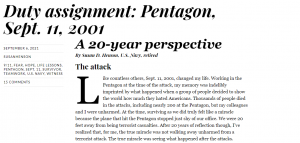Nick Metcalfe's Blog, page 4
June 4, 2022
Major Robert Norman Dodds MBE, MC, DCM, MM
This blog post originally appeared on my site dealing with Honours and Awards to Royal Signals. It is reposted here in anticipation of that site’s closure.
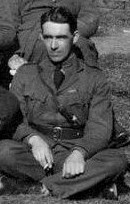
Second Lieutenant R. N. Dodds MC, DCM, MM, Russia, 1920
One hundred and two years ago, on 22 May 1920 the former Royal Navy hospital ship and troop transport SS Dongola arrived in England carrying some of the last British and French refugees to flee Bolshevik Russia. Amongst the passengers was also the final batch of British prisoners of war, who had been captured a year before during the operations in North Russia. One of their number was Second Lieutenant Robert Dodds MC, DCM, MM of the Royal Engineers Signal Service.
Dodds was commissioned into Royal Signals just prior to the Second World War and was made an MBE for his service in North Africa. I came across him while researching something completely different a few years ago and intrigued by his multiple decorations—he was one of only two men to receive this combination of awards[1]—I saved on my computer the London Gazette that recorded his retirement, meaning to return to it later. It became one of the catalysts that promoted my wider study of Royal Signals gallantry awards.
He is an excellent example of a significant number of decorated soldiers whose gallantry awards are, by necessity, consigned to a brief mention in the Register of Awards. It was an aspiration to record the awards made to those who earned them prior to joining Royal Signals but that has proven to be an impossible task to complete accurately. Nonetheless, the full story of Dodds’ repeated gallantry is worth recounting.
Early Life and First World War
Robert Norman Dodds was born on 25 November 1895 at Lemington, Northumberland (now part of Newcastle-upon-Tyne); he was baptised in the Church of the Holy Saviour in Sugley on 7 January 1896. His father, Thomas,[2] was a clerk at Spencer’s Steel Works and after he left school Robert Dodds joined Spencer’s to work with the mill’s chemist.
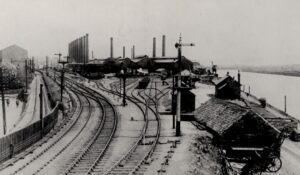
Spencer’s Steel Works, 1920
In 1912 he enlisted into the Territorial Force and joined the Northumbrian Divisional Engineers.[3] The unit was training in North Wales when war broke out and immediately returned to Newcastle, where it was formally mobilised the next day. Initially engaged in its war role to protect and maintain the industrial infrastructure around Newcastle, most men volunteered for overseas service and the Northumbrian Division embarked for France in mid-April 1915.[4] Dodds, by now a Lance Corporal, disembarked at Le Havre with the leading elements of the Divisional Signal Company on 17 April and two days later joined the Divisional Headquarters at Steenvorde near the Belgian border.[5] The Division’s brigades were soon detached to other divisions and committed to the Second Battle of Ypres. Lance Corporal Dodds was in No. 2 Section, which supported the Northumberland (later 149th) Brigade. The Section’s first casualties occurred on 25 April when the Section Commander, Lieutenant Bainbridge was killed in action and five Sappers were wounded.[6]
By the late spring of 1916 Dodds had been promoted to Serjeant. His first award for gallantry was the new Military Medal, instituted on 25 March 1916 for ‘…non-commissioned officers and men for individual or associated acts of bravery…in the Field’.[7] The first awards, including Serjeant Dodds’, were announced in the Birthday Honours on 3 June 1916.[8] It is not known in which action it was earned but it was one of five gallantry awards to officers and men of the Divisional Signal Company that appeared in this Gazette, and which were recorded in the Company’s war diary.[9] Serjeants Dodds and Jensen were presented with their medals by Lieutenant General Sir William Pulteney,[10] General Officer Commanding III Corps, at a ceremony on the afternoon of 28 August 1916.
Serjeant Dodds’ second award—the Distinguished Conduct Medal—was noted in the Company’s war diary on 20 December 1916 and published in the London Gazette on 26 January 1917.[11] This award was for his gallantry during the attack in atrocious conditions by 149th Brigade against Gird Trench and Hook Sap near the Butte de Warlencourt, north-east of Le Sars, on 14 November 1916.[12] The Signal Company’s war diary recorded: ‘Communications with Brigade maintained throughout operations. Communications with front line lost periodically. Very valuable information sent back by pigeons.’ Dodd’s citation stated:
‘For conspicuous gallantry in action. He organised parties for laying and maintaining telephone cables under very severe fire. He set a splendid example throughout.’[13]
Later in the year Serjeant Dodds was wounded and evacuated for treatment at hospital in the United Kingdom. When he recovered from his injuries he was posted as an instructor to the Royal Engineers Signal Service Training Centre at Haynes Park in Bedford. There he was selected for a commission and joined the Royal Engineers Officer Cadet Battalion. He was commissioned into the Corps of Royal Engineers on 23 March 1918.[14]
Russia
Dodds volunteered to serve with the force being raised for service in North Russia and arrived in Murmansk in the autumn of 1918 to join the Signal Company supporting ‘Syren Force’. A transcription of a letter that he wrote in April 1919 to Captain A. E. Odell MC, an officer with whom he had served in France, gives some idea of his work.[15]
‘8.4.19
Dear Mr O’Dell,
No I never got the letter you ask about, but your letter of the 2-2-19 was more than welcome. I really was beginning to think you had quite forgotten me in your busy time but as you haven’t I will try & tell you a little about myself though there really isn’t much to tell—Well one is really up against it here because one has no trained men to work with & the shortage of personnel is another great drawback. In fact the only men who can do Morse are the wireless personnel. Then the communications are so extensive (mine being 100 square miles being i/c of Sig’s of one of the forces) My personnel consists of a total of 30 n.c.o’s & men—6 of them being W/T operators, 15 Russians & the rest British speaking men who don’t know anything about the work & who I use as exchange operators—I’ve three exchanges & about 100 phones in use & it takes one going all day to keep things in order—then we often do stunts—quick moving one’s I use sleigh’s & have had made as cable wagon’s & lay about fifteen miles at a stretch. Another tough problem is where we have to keep Comms with a party marching through the woods, we have to wear snow shoe’s & I’ve had two small sleighs made one to run off the cable & the other to carry 10 miles of DII cable. (We find DII best as its very light & when one has to pull it, it’s rather a job) of course we put it on the trees as much as posts & often thank God that we have no ladder lines as I am afraid I would have to do the work myself. Another difficulty is the breaking of the ice well I’ve got to cross a river 300 yds wide twice—but the worse period is when the ice begins to break & when the river is free from ice – as I am afraid submarine cable will get cut to pieces by the ice packing – anyway I am trying three methods. Permanent line, ordinary cable under water & lead covered cable & I am hoping one of them holds good.— I’ve already got the P. L. across. But I’m afraid the span is too great & I’ve got the ordinary cable under the ice & buried four feet on each bank & wooden piles put in where the cable enters the water to protect the cable & now I’ve only to put the lead covered in—anyhow I hope for the best—But I would give anything to have the old section here then one would be able to cope with difficulties of any kind—still I’m hoping to keep the Commn going as I’ve never lost it yet.
I shouldn’t mind being with you again at Eaucourt l’Abbeye. Just to have the old times over again—though I confess they were pretty hot—but its dreadfully cold here & I need a change.—Re the demobilisation well they have talked a lot about it here—but that’s all—& I may say that I am quitting the army at first opportunity but it may not be to go back to test tubes. I’ll throw them down in disgust—if something more exciting turns up I’ll switch off the test tube’s & take on the exciting hiss.—I wonder if you are out of the army by this time I hear quite a lot are. Trusting you are in the best of health.
With best wishes.
Yours sincerely
R. N. Dodds’
In March and April 1919 at Bolshie-Ozerki[16] British soldiers of 6th Battalion, Alexandra, Princess of Wales’s Own (Yorkshire Regiment) and United States soldiers of 339th Infantry Regiment faced a much larger Red Army force in a series of bitter engagements in harsh weather conditions. Here Dodds added a Military Cross to his decorations:
‘During the attacks on Bolshee-Ozerki (sic) on 23rd March and 2nd April 1919, he worked unceasingly under heavy fire from the enemy, and, after having established signal communication, continued, at great personal risk, to keep in touch with the different attacking parties. It was his disregard for danger and splendid spirit that inspired his men to keep up communication at all risks when exposed to great danger.’[17]
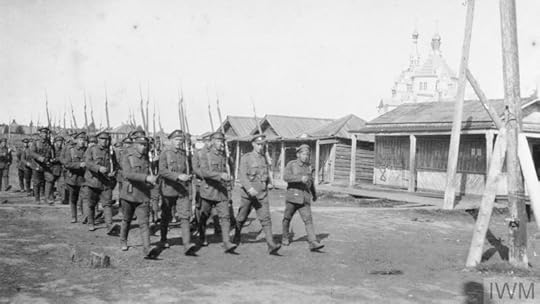
North Russia Rifles, 1919
With word spreading of the imminent Allied withdrawal, in July 1919 White Russian troops in the Arkhangelsk Governorate mutinied.[18] Dodds was part of the Onega River Force, a formation of White Russian units, with a British liaison staff led by Lieutenant Colonel R. J. Andrews DSO, MC.[19] The headquarters of the force was based at Chekuyevo, near Onega, garrisoned by 5th Regiment, North Russian Rifles. In the most serious of the mutinies, on 20 July the Russian mutineers took prisoner 10 officers and 22 other ranks of the British liaison staff, a visiting staff officer, and their own Russian officers; they then surrendered the Onega front to the Bolsheviks. At Kleshova the mutineers murdered Captain Allan Brown, a British born officer of the Australian Imperial Force.[20]
In his report after repatriation, Dodds wrote:
‘…on the 20 July ‘19 at about 12 noon whilst working in my office I heard a commotion in the street – in looking out of the window I saw Col. Andrews and the Russian Colonel with some Russian soldiers – I went outside (without any arms) to see what was the matter & found that the Russian troops had revolted and had taken the two Colonels prisoners and also found myself in the same predicament – I was then taken to the guard room and the same evening handed over to the Bolo.’ [21]
All of the British prisoners were sent to Vologda, (where a White Russian interpreter, Sergeant I. C. Siminoff, was shot), and then on to Moscow, which they reached on 10 August and where they remained until repatriation. In Moscow one British soldier, Sergeant E. G. Blunden, died in September that year.[22]
In early May 1920, Dodds was amongst a party of 16 officers and four other ranks transported by train to Sestroretsk, north-west of St. Petersburg on the Sestra River (then the border with Finland). With 340 British, French and Danish refugees, the released prisoners sailed onboard the SS Dongola from the Finnish resort port of Terijoki (now Zelenogorsk, Russia) on 13 May via Helsinki and Copenhagen; they arrived back in England on 22 May.
Dodds relinquished his commission in August 1920 and was granted the rank of Captain. He returned home and, true to his word, did not return to the steel mill chemist’s shop. Instead he worked as a farmer at Corbridge-on-Tyne, near Hexham. There he married Mary Burdus, a farmer’s daughter, in the spring of 1921.
Second World War
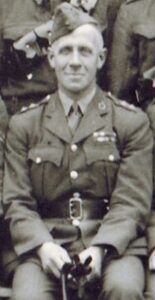
Lieutenant R. N. Dodds MC, DCM, MM
On the outbreak of the Second World War, Dodds was granted an emergency commission in Royal Signals. He served in Eighth Army Signals during the Western Desert Campaign and for his conduct during the withdrawal from Tobruk to El Alamein in June 1942 he was awarded an MBE:[23]
‘This officer was in charge of the rear parties of linemen who were responsible for keeping all the permanent lines of Eighth Army through till the last moment, destroying them when ordered and then withdrawing. This necessitated a very complete knowledge of all the lines in successive positions, a complete liaison with surrounding units and formations, good positioning of his parties and a very fine judgement in giving the executive order to withdraw at the right moment compatible with the parties not becoming casualties. Major Dodds carried out this duty during the whole withdrawal from Tobruk to El Alamein. His cheerful help and advice and efficient handling of the situation at all time was largely contributory to the efficiency of line communications of Eighth Army throughout the withdrawal.[24]
Captain Robert Norman Dodds MBE, MC, DCM, MM left the Army at the end of the war in 1945 and returned to Corbridge-on-Tyne; he was granted the honorary rank of Major. In 1946 became the county Secretary of the National Farmers Union, a post that he held for 15 years. He died on 21 November 1973, just before his 78th birthday, at Close House residential care home in Hexham.
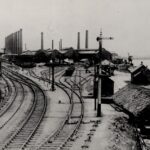
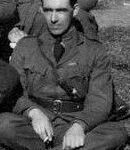
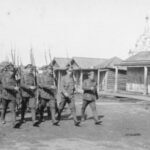
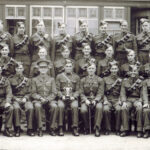
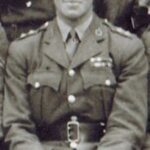
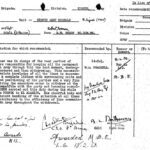
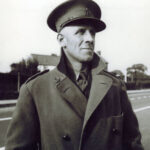
1. (Back) The other was Major John Joseph Heath MBE, MC, DCM, MM, The Royal Warwickshire Regiment, who also earned his Military Cross, Distinguished Conduct Medal and Military Medal in the First World War and was made MBE for his service in the Second World War.
2. (Back) Thomas Dodds married Annie Heddon on 20 June 1892 at Heddon-on-the Wall, Northumberland. There were two older children of the marriage: Herbert James and Jane Heddon Dodds. Herbert Dodds served with The Northumberland Fusiliers during the First World War before being commissioned into The Durham Light Infantry in 1917. He was attached to the Corps of Army Accountants in 1919 and relinquished his commission in 1921. In the inter-war years, he established business as an accountant in Staffordshire. He was appointed to a commission in the Second World War but was dismissed from the Army after being convicted of fraud on 14 July 1944 and sentenced to three years penal servitude.
3. (Back) Dodds was allocated the regimental number 1934 and was renumbered 463188 when the Territorial Force changed its numbering system in 1917.
4. (Back) On 13 May 1915, the Northumbrian Division became 50th (Northumbrian) Division.
5. (Back) The National Archives (TNA). War Diary of 50th Northumbrian Divisional Signal Company. WO 95/2822/1.
6. (Back) Killed in action: Lieutenant Thomas Lindsay Bainbridge, 1/5th Battalion, The Northumberland Fusiliers attached to the Northumbrian Divisional Signal Company; he is buried in Birr Cross Roads Cemetery. Wounded: 1950 Sapper R. White; 1929 Sapper A. E. Bennett; 1945 Sapper F. Short; 1931 Sapper H. W. Brown; and 1946 Sapper W. Storey.
7. (Back) LG 5 April 1916; 29535, p. 3647.
8. (Back) LG 3 June 1916; 29608, p. 5589.
9. (Back) Other awards: Military Cross: Captain Charles Lane Bagnall and Captain Arthur Godfrey Shaw (both infantry attached). Military Medal: 1442 Serjeant N. Jensen, and 1360 Corporal W. J. Rushforth.
10. (Back) Later Lieutenant General Sir William Pulteney GCVO, KCB, KCMG, DSO.
11. (Back) LG 26 January 1917; 29921, p. 1023.
12. (Back) TNA. Gazette of Distinguished Conduct Medal, pages 001 – 074. WO 391/5/1.
13. (Back) For a full account of this action by 50th (Northumbrian) Division see: Wyrall, E. (1939). The Fiftieth Division: 1914-1919. pp. 183-191. Bradford: Percy Lund, Humphries & Co.
14. (Back) LG 20 April 1918; 30641, p. 4791.
15. (Back) Dodds, R. N. (8 April 1919). Letter to Captain A. E. Odell MC. The Estate of Albert Edward Odell.
16. (Back) Now Shchukozerye, Arkhangelsk Oblast.
17. (Back) LG 15 July 1919; 31456, p. 8980.
18. (Back) On 7th July, 1st Battalion, Slavo-British Legion (a White Russian unit trained and equipped by the British) mutinied. Four British officers were murdered and a fifth later died of his wounds: Lieutenant Cecil Francis Ramsden Bland MC, The Princess Charlotte of Wales’s (Royal Berkshire Regiment); Captain Aubrey Malcolm Cecil Finch, Seaforth Highlanders (Ross-shire Buffs, The Duke of Albany’s); Lieutenant Gerald Noel Gosling MC, The Gloucestershire Regiment; and Lieutenant Thomas Comber Griffith, The Loyal North Lancashire Regiment. All were buried together in a single grave in Semenovka British Cemetery, Bereznik on the southern bank of the Dvina River; all are commemorated on special memorials in Archangel Allied Cemetery. Captain David Buik Barr MC, The East Lancashire Regiment died of wounds on 13 July 1919; he is buried in Archangel Allied Cemetery.
19. (Back) Lieutenant Colonel Richard John Andrews DSO, MC, The Welsh Regiment. Andrews died in an accident in 1923.
20. (Back) Brown, who served during the First World War with 49th Battalion, Australian Imperial Force at Gallipoli and in France, was buried in Kleshova Cemetery and reinterred in Archangel Allied Cemetery on 3 June 1925. On 22 July, a detached force of 5th Regiment, North Russian Rifles at Kozheozersky Monastery also mutinied and arrested its officers and two British officers and a sergeant. On 25 July, the Royal Navy monitor HMS M.26, commanded by Lieutenant Commander Arthur Charles Fawssett, rescued the elements of the British force at Onega that had not been handed over to the Bolsheviks. Lieutenant Commander Fawssett was awarded the Distinguished Service Order: ‘For distinguished services in command of HMS ‘M26’, and in charge of operations off Onega, 30th July to 2nd August 1919, which he carried out with great skill, courage and coolness. LG 11 November 1919; 31638, p. 13745.
21. (Back) TNA. War Office: Officers’ Services, First World War, Long Number Papers. Lieutenant Robert Norman Dodds, Royal Engineers. WO 339/116739.
22. (Back) S/436619 Sergeant Edward George Blunden, Royal Army Service Corps died in Moscow on 1 September 1919. He is commemorated on the Archangel Memorial, Archangel Allied Cemetery, Russia.
23. (Back) LG 18 February 1943; 35908, p. 860.
24. (Back) TNA. Recommendation for Award for Dodds, Robert Norman. WO 373/76/513. Originally recommended for a Bar to the Military Cross, the recommendation was changed to an MBE by Lieutenant General Sir Bernard Montgomery, who initialled the change.
February 9, 2022
For Exemplary Bravery – The Queen’s Gallantry Medal – Update, December 2021
Following the civilian gallantry awards list published in the London Gazette in May 2021, I have updated the addendum to For Exemplary Bravery—it records the 50 Queen’s Gallantry Medals announced since the book was published in 2014, with new information about a number of previous recipients and some new photographs. The addendum is a pdf in a similar format to the book and it can be downloaded (free) here.
The post For Exemplary Bravery – The Queen’s Gallantry Medal – Update, December 2021 first appeared on Nick Metcalfe.November 18, 2021
The Dedication of the Ulster Battlefield Memorial Tower, 19 November 1921
My great-grandfather, Sergeant William Neill DCM, served with 9th Royal Irish Fusiliers—Blacker’s Boys—during the First World War. One hundred years ago he returned to the Somme, to Thiepval, for the dedication of the Ulster Battlefield Memorial Tower. This is an account of the events and includes a gallery of the memorabilia that he kept. It also includes a scene-by-scene description of the news clip filmed for Pathé News, in which he appears at the very end.
[image error]Ulster Tower
The Ulster Battlefield Memorial Tower was proposed in November 1919 by Sir James Craig MP. Based on Helen’s Tower at Clandeboye in County Down, it was designed by Bowden and Abbott Ltd of London[1] and built quickly by Fenning & Co Ltd, specialists in granite memorials, and the Société de Construction et Travaux Publics d’Arras. (See the plans here.) The land had been purchased from three families that farmed the area around Thiepval. The Ulster Tower, as it has become known, was the first official memorial raised on the Western Front—it was opened and dedicated on Saturday 19 November 1921. The tower is owned by the Somme Association and you can read more about its centenary here.
The level of planned representation indicates the importance of the ceremony. The original intention was for the Prime Minister of Northern Ireland, Sir James Craig, to welcome the visitors and for Lord Carson to unveil the commemorative tablet in the memorial chamber but both were ill and unable to attend.[2] The party that travelled to the ceremony numbered about 100, including Field Marshal Sir Henry Wilson Bt., GCB, DSO, Chief of the Imperial General Staff, representatives of all of the battalions of the division and some widows and mothers of the fallen. A list of those who attended and participated in the ceremony may be found .
A newspaper appeal had been published on Friday 28 October 1921 to raise the funds required to send to the ceremony representatives of the units of 36th (Ulster) Division that fought on 1 July 1916. As a result a large contingent of men was sent (the linked document includes information about the signatories of the original appeal in addition to details of the men sent).
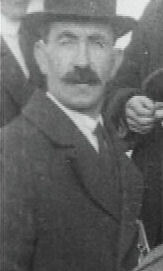
Sergeant William Neill DCM, Ulster Tower, 1921
The trip was organised by Cook’s Tours and my great-grandfather and his colleagues travelled to England on the 9.00pm Heysham ferry on Wednesday 16 November and then by train the following morning to London, where they stayed at the Imperial Hotel, Russel Square (see the gallery for the original programme for the trip). On Friday 18 November they travelled to Dover, sailed for Calais, and travelled by train to Amiens. There they were greeted by the mayor and senior French Army officers, a guard of honour and a large crowd. A military band played the national anthem of both countries. The visitors stayed overnight in Amiens. It was originally planned that Major General Nugent would give an account of the Thiepval attack during the ceremony but, due to constraints on time, it was decided that he would speak at a meeting at the Hotel du Rhin the evening before. His overview was very well received, as were the additional comments by Captain C. C. Craig MP, the brother of Sir James Craig—he was a company commander during the attack and had been wounded and captured. Field Marshal Sir Henry Wilson spoke about the war generally. It is unlikely that many of the audience who had been at Thiepval or Hamel on 1 July 1916 would otherwise have heard about the attack from their perspective.
The next morning, which was frosty but clear, the visitors departed from Amiens in a convoy of motor cars and charabancs. The journey, about thirty miles, was at first uneventful and no signs of the destruction wrought by the war were obvious. As the convoy approached Albert, however, that changed. Albert was still in ruins—not one building that stood in 1914 had survived—and beyond the town the roads were badly cut up. As the convoy approached the memorial along a narrow road (now the D73) the devastation of Thiepval Wood and the British and German trenches could be seen, altered little since the end of the war. The whole event was thoroughly described in the Belfast Newsletter of Monday 21 November, which recorded a first impression of the tower:
‘Like Helen’s Tower it is ‘dominant over sea and land,’ and in the glittering sunshine which flooded the landscape on Saturday, relieving it of much of the drabness which the ravages of war have imposed on it, the building looked exceedingly beautiful.’[3]
The ceremony was due to begin at 11.00am but was delayed by about an hour because a car bringing some of the visitors from Amiens had broken down. This gave the visitors the opportunity to look at the trenches nearby. The area was littered with rusting rifles, helmets, and the detritus of war, including items of clothing, reflecting the fighting that had ebbed and flowed over this ground for four years. The barbed wire that still protected the trenches caught and ripped the coats of the unwary.
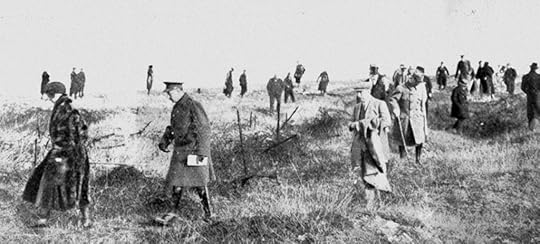
Participants at the dedication ceremony viewing the battlefield
A French guard of honour was in place for the arrival of Field Marshal Sir Henry Wilson, who inspected the troops as he walked to the tower accompanied by General Maxime Weygand, the former chief of staff to Marshall Foch.
Major J. C. Boyle, who had been commissioned into the 9th Royal Irish Fusiliers on its formation and transferred to the Corps of Royal Engineers in 1915, was an original member of the memorial committee and stood in for Sir James Craig. He formally asked Field Marshal Sir Henry Wilson to open the tower—the silver key was presented to the Field Marshal in a casket inscribed:
Presented to Field-Marshal Sir Henry M. Wilson, Bart., G.C.B., D.S.O., Chief of the Imperial General Staff, first Colonel Commandant of the Royal Ulster Rifles, on the occasion of the opening by him of the Ulster Battlefield Memorial Tower at Thiepval, 19th November, 1921, on behalf of the subscribers.
The Field Marshall then addressed the French troops and the French visitors to the ceremony in French, after which the memorial committee and senior visitors went into the memorial chamber. The memorial chamber, sixteen feet along each side, has a lintel around the room inscribed with words written by Lord Tennyson of Helen’s Tower:
Helen’s Tower here I stand,
Dominant over sea and land.
Son’s love built me, and I hold
Ulster’s love in lettered gold.
Here General Weygand unveiled the commemorative tablet, made of white marble.
Thereafter followed a service of dedication led by the Primate of All Ireland, the Most Reverend Dr C. D’Arcy, the Moderator of the Presbyterian Church, the Right Reverend Dr W. J. Lowe, and the President of the Methodist Church in Ireland, the Reverend W. H. Smyth. All spoke at length about the men of the Ulster Division and their achievements and also of the ‘cause of Ulster’. At the end of the service of dedication Lieutenant Colonel Sir William Allen formally handed over the custody of the tower to the committee of the Ulster Volunteer Force Patriotic Fund, represented by Sir Robert Liddell. Both men spoke and then, following a final benediction, the national anthem was sung.
To cheers from the crowd, the Duchess of Abercorn appeared on the tower roof and proceeded to unfurl a Union Flag and the French Tricolour; both were then raised together. In front of the tower were laid numerous wreaths and the final act was conducted by the representatives of the units and organisations associated with 36th (Ulster) Division, who planted trees brought from Ireland to form an avenue leading to the tower from the road. A list of those who planted the trees, who included my great-grandfather, may be found here.[4] Unfortunately, the trees and shrubs proved unsuited to the chalky soil and were replaced with hardier plants in the 1930s. In turn, during the Second World War these could not be tended and many succumbed to disease. They were later replaced with an avenue of ornamental purple plum trees. During the refurbishment of the Tower in the late 1980s Irish yew trees were planted.
The event was filmed for Pathé News and may be found in the archive of British Pathé. Titled ‘Ulster Cenotaph to Her Heroic Dead’ the clip runs for one minute and 15 seconds (due to the prohibitive cost of licensing this item, readers should view it on the Pathé News site or on the Pathé channel on Youtube):
0-8 seconds: The title shot.
9-17 seconds: Field Marshal Sir Henry Wilson walks between the ranks of the French guard of honour accompanied by the guard commander on his left and General Weygand on his right.
18-32 seconds: A view of some of the guests and participants during the remarks by Field Marshal Sir Henry Wilson, who opened the tower. On his right, from the right: Duchess of Abercorn, Lady French, Captain C. C. Craig MP, and Lieutenant Colonel Sir William Allen KBE, DSO, MP. On his left, from the left: The Lord Archbishop of Armagh and Primate of All Ireland, Most Reverend Dr C. D’Arcy; the Moderator of the General Assembly of the Presbyterian Church in Ireland, Right Reverend Dr W. J. Lowe (somewhat hidden); and the President of the Methodist Church in Ireland Reverend W. H. Smyth. Behind on the right, from left: Reverend C. C. Manning MC and Reverend J. A. Carey.
33-52 seconds: A general view of the guests and the tower while the unveiling of the memorial tablet was taking place inside.
53-59 seconds: The service of dedication led by the Primate of All Ireland (on the steps with Reverend W. H. Smyth behind him) and, in front, Reverend C. C. Manning MC and Reverend J. A. Carey.
59-67 seconds: Field Marshal Sir Henry Wilson with, on the far right, Frederick Hamilton-Temple-Blackwood, Marquess of Dufferin and Ava, DSO, PC, and his wife.
68-75 seconds: Sergeant Joseph Savage, formerly Royal Irish Rifles, and his French wife, the first caretakers of the tower. At the end, appearing from the left and turning to face the camera, is my great-grandfather, Sergeant William Neill DCM.
After the ceremony the visitors had lunch in Albert at the newly rebuilt salle de fêtes (the village hall), which was followed by several speeches and toasts. The following day, 20 November, most of the party toured the area of the local battlefields by car and my great-grandfather and his party returned to London on 21 November, again staying at the Imperial Hotel. On the night of 22 November they took the 11.00pm ferry from Heysham to Belfast, arriving there the following morning.
Gallery: The trip memorabilia kept by Sergeant William Neill DCM:
[image error] [image error]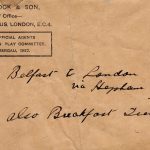
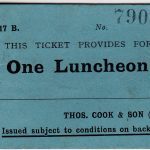
 [image error]
[image error]
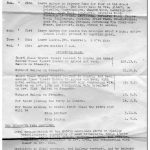
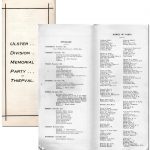


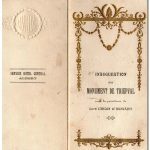
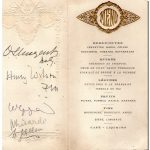
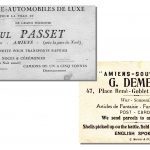
 [image error]
[image error]

Gallery: The tree markers:
[image error] [image error]
 [image error]
[image error]
Gallery: The ceremony:

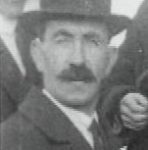

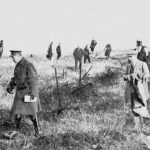 [image error]
[image error]
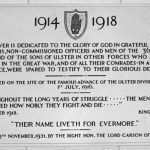 [image error]
[image error]
[image error]
[image error]

1. (Back) Mr. James Albert Bowden FRIBA and Lieutenant Colonel Albert Leigh Abbott MC, TD, FRIBA.
2. (Back) Having been prepared before his illness, it is Lord Carson’s name that is inscribed on the memorial tablet.
3. (Back) Belfast Newsletter, 21 November 1921, pp. 5-8.
4. (Back) This has been compiled for several sources including the list on the wall of the memorial room and numerous newspaper accounts.
September 22, 2021
The Book Cover Explained
This blog post on the website for my new book describes the images used on the book cover.
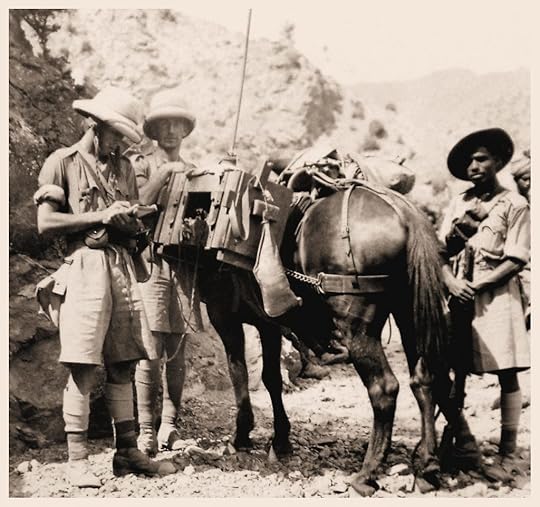
Signalman J. Petrie, Waziristan District Signals and his W/T detachment in Waziristan in 1937.
The post The Book Cover Explained first appeared on Nick Metcalfe.September 13, 2021
Honours, Decorations, and Medals to The Royal Corps of Signals for Gallantry & Distinguished Service 1920-2020
At last the new book is finished and on its way to the printer!
Honours, Decorations, and Medals to The Royal Corps of Signals for Gallantry & Distinguished Service 1920-2020 will be published by 30 September 2021. (ISBN 9781916264311)
It will be available through online retailers (such as Amazon) or by ordering through local bookshops; it may be pre-ordered online closer to the publication date. You can read more on the project website.
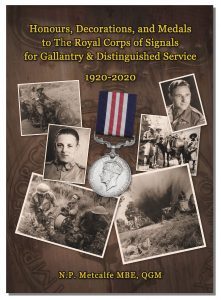
September 10, 2021
September 11…
There is lots being written about what should and should not have been done after 9/11, the terrorist attacks in New York and Washington DC 20 years ago. It is worth, however, remembering the many thousands grievously impacted by the events of that day. My friend Susan Henson was working in the Pentagon when the hijacked American Airlines Flight 77 hit the western side of the building. For the first time she has told her story—it’s well worth reading.
The post September 11… first appeared on Nick Metcalfe.December 13, 2019
For Exemplary Bravery – The Queen’s Gallantry Medal – Update, December 2019
[image error]Following the recent civilian gallantry awards list published in the London Gazette in September 2019, and the Armed Forces operational awards list published in November, I have updated the addendum to For Exemplary Bravery—it records all the 46 Queen’s Gallantry Medals awarded since the book was published in December 2013, with new information about a number of previous recipients and some new photographs. The addendum is a pdf in a similar format to the book and it can be downloaded (free) from the book’s website.
[image error]
The medals of former Warrant Officer Class 1 J W McNair QGM, who earned his Queen’s Gallantry Medal during and in the aftermath of an attack by artillery and tanks on civilians at Konjević Polje in Bosnia and Herzegovina in 1993.
November 14, 2019
Honours, Decorations and Medals to the Royal Corps of Signals for Gallantry & Distinguished Service, 1920-2020
[image error]My new book will be published by the Royal Signals Institution in May 2020.
In two sections and with supporting appendices, this book records all honours, decorations and medals to Royal Signals since May 1920.
Giving primacy to awards for bravery, the first section of the book puts the various awards in context by taking a chronological tour through the history of Royal Signals in three eras—the campaigns of the inter-war years, the Second World War, and global conflict and insurgency since 1945.
The second section comprises the register of awards. Revealing many previously undiscovered citations, it includes all honours, decorations and medals for gallantry and distinguished services on operations, awards for non-operational service announced in the Birthday and New Year honours lists, foreign awards, the Polar Medal, and a full register of over 6,500 mentions in despatches and various King’s and Queen’s commendations for bravery and valuable service. Finally, there are eight supporting appendices—six record awards to various Empire and Commonwealth signal units inextricably linked to Royal Signals in time of conflict or war, one records awards to Auxiliary Territorial Service and Women’s Royal Army Corps all ranks who served with Royal Signals, and one records awards to Queen’s Gurkha Signals.
There’s much more information and some fascinating tales on the project website.
August 24, 2019
‘Class ‘B’ Mentions’—Rewards for Valuable Services Published in The Times during the First World War
As I was working through one of the registers in my Royal Signals honours and awards project, I came across an anomaly. The obituary in The Wire for Major General A. C. Fuller CBE—the inventor of the Fullerphone—records that he was mentioned in despatches four times and that he did not receive the Victory Medal. These statements are at odds—if he did not serve in a theatre of war he could not have been mentioned in despatches. There are some exceptions to that statement, but Experimental Officers at the Signals Experimental Establishment were not amongst them. A little more digging revealed that these were ‘class ‘B’ mentions’ for ‘valuable services in connection with the war’. I was unable to track them down easily, however, and this post is the result of my research into where such awards may be found.
[image error]
An extract from War Office List of 23 March 1919 showing Scottish officers; the full list was not published in The Times. (The Courier, 23 August 1919.)
Meritorious service by military personnel and civilians at home was recognised largely only in the latter years of the war, primarily by the various grades of the Order of the British Empire, created in June 1917. In addition, a lower category of commendation, the equivalent in broad terms of a mention in despatches, was made available for those who were brought to the notice of the Secretary of State for War or Home Secretary. They are often referred to as ‘class ‘B’ mentions’. Most were for service in the United Kingdom, but some awards were made for service in the Dominions and Colonies.
Although the War Office, Air Ministry and Home Office lists, or communiqués, were described as supplements to the London Gazette, they did not appear in the Gazette but were instead provided to the Press for publication. Extracts may be found in regional newspapers, often highlighting the work of local recipients, but The Times became seen as the ‘official’ avenue of publication because it featured the full lists. The first communiqué appeared in February 1917 and the last in May 1920.[1] Similar lists were announced by the Admiralty, although they do not appear to have been published by The Times in the same way.[2]
Several lists were not published in The Times—for example, a list of Army officers dated 23 August 1919 may be found in part only as extracts in some regional newspapers.
In early 1920 a bronze spray of oak leaves was authorised for wear by those who had been mentioned in despatches (to be worn on the Victory Medal and retrospective to the beginning of the war), but no such emblem was authorised for class ‘B’ mentions. They were recorded, however, in the service records of military personnel.
[image error]
An extract from the service record of 924 (Acting) Company Quartermaster Sergeant George Dennis Ruggles, who was rewarded for his service with the Household Brigade Officer Cadet Battalion at Bushey in Hertfordshire.
Below are details of each of the lists—the date of the communiqué, the categories of those rewarded for their service, the ‘citation’ as published in The Times (which may differ in minor ways from that of the communiqué) and the details of when the list appeared in The Times. There are two good sources for the relevant pages of The Times, both require subscription: The Times archive and Fold3. Regional newspapers may be searched on sites such as The British Newspaper Archive.
War Office List—24 February 1917.
British Army Officers and Other Ranks, and Army Officers and Other Ranks in the Dominions and Colonies.
The names of the following have been brought to the notice of the Secretary of State for War for valuable services rendered in connection with the war.
The Times, 26 February 1917, p 12, continued p 13. British Army Officers.
The Times, 27 February 1917, p 11. British Army Other Ranks, and Army Officers and Other Ranks in the Dominions and Colonies.
War Office List—3 March 1917.
Military Nursing Services, Civilian Nurses and Voluntary Aid Detachments.
The names of the following ladies have been brought to the notice of the Secretary of State for War for valuable services rendered in connection with the war.
The Times, 5 March 1917, p 6.
War Office List—5 April 1917.
British Army Officers and Other Ranks.
The following are added to the names of those which have been brought to the notice of the Secretary of State for War for valuable services rendered in connection with the war.
The Times, 5 April 1917, p 9.
(Included are corrections to War Office List—24 February 1917.)
[image error]
Lieutenant Colonel Frederick Hibbert Westmacott FRCS, TD, Royal Army Medical Corps, (1867-1935) commanded 2nd Western General Hospital in the Manchester area from October 1915 to April 1917 before moving to France, where he commanded No. 57 General Hospital. He was mentioned in the War Office List of 5 April 1917. For his war service he was made CBE in 1919 (LG 3 June 1919; 31370.)
War Office List—7 August 1917.
British Army Officers and Other Ranks, and Army Officers and Other Ranks in the Dominions and Colonies.
The names of the following have been brought to the notice of the Secretary of State for War for valuable services rendered in connection with the war.
The Times, 7 August 1917, p 10.
(Included are corrections to War Office List—24 February 1917.)
War Office List—1 September 1917.
Royal Navy, Royal Naval Volunteer Reserve, Royal Marine and Royal Marine Artillery Officers.
The following are added to the names of those which have been brought to the notice of the Secretary of State for War for valuable services rendered in connection with the war, published on August 7, 1917.
The Times, 3 September 1917, p 10.
(Included are corrections to War Office List—7 August 1917.)
War Office List—18 September 1917.
Officers of the Medical Services.
The names of the following have been brought to the notice of the Secretary of State for War for valuable medical services rendered in connection with the war.
The Times, 19 September 1917, p 8.
War Office List—18 October 1917.
Military Nursing Services, Civilian Nurses and Voluntary Aid Detachments.
The names of the following have been brought to the notice of the Secretary of State for War for valuable services rendered in connection with the war.
The Times, 20 October 1917, p 4.
The Times, 22 October 1917, p 2.
The Times, 23 October 1917, p 4.
[image error]
Sister Miss Sara Burnley, Auxiliary Military Hospital, Ilkley, and Probationer Nurses Miss Dorothy Forster and Miss L. S. Sargent, St. Luke’s Hospital, Bradford. All were mentioned in the War Office List of 18 October 1917.
War Office List—20 December 1917.[3]
British Army Officers and Other Ranks (Anti-Aircraft Defences).
The names of the following have been brought to the notice of the Secretary of State for War for valuable services rendered in connection with anti-aircraft service in the United Kingdom, and, when applicable, an entry will be made in the records of service of officers and other ranks.
The Times, 21 December 1917, p 11.
War Office List—29 January 1918.
Patrons and Staff of Hospitals.
The names of the following ladies have been brought to the notice of the Secretary of State for valuable services rendered in connection with the establishment, maintenance, and administration of hospitals.
The Times, 2 February 1918, p 4.
War Office List—12 March 1918.
(1) Civilian Nurses and Voluntary Aid Detachments in the United Kingdom and Malta.
The names of the following have been brought to the notice of the Secretary of State for War for valuable nursing services rendered in connection with the war.
(2) Ladies of the Almeric Paget Military Massage Corps.
The following members of the Almeric Paget Military Massage Corps have been brought to the notice of the Secretary of State for War for valuable services rendered during the war.
The Times, 14 March 1918, p 4.
(Included are corrections to War Office Lists—3 March and 18 October 1917.)
War Office List—13 March 1918.
British Army Officers and Other Ranks, and Army Officers and Other Ranks in the Dominions and Colonies.
The names of the following have been brought to the notice of the Secretary of State for War for valuable services rendered in connection with the war, and when applicable an entry will be made in the records of service of officers and other ranks.
The Times, 15 March 1918, p 4. British Army Officers (surnames A-W).
The Times, 16 March 1918, p 10. British Army Officers (surnames W (continued)-Y) and Other Ranks, and Army Officers and Other Ranks in the Dominions and Colonies.
War Office List—1 May 1918.
Royal Army Medical Corps (one officer) and the Legation Guard, Peking.
The following are added to the names of those who have been brought to the notice of the Secretary of State for War for valuable services rendered in connection with the war, published on March 13, 1918.
The Times, 2 May 1918, p 4.
(Included are corrections to War Office Lists—24 February, 7 August, 18 September and 20 December 1917, and 13 March 1918.)
Air Ministry List—14 June 1918.
(1) Royal Air Force Officers and Other Ranks.
The following Officers and other ranks of the Royal Air Force have been brought to the notice of the Secretary of State in respect of the valuable services they have rendered in connection with the war, and a record to this effect will accordingly be made in their Official Records.
(2) Royal Air Force Civilians.
The following ladies and gentlemen employed by the Air Ministry have been brought to the notice of the Secretary of State War in respect of the valuable services they have rendered in connection with the war.
The Times, 15 June 1918, p 5.
War Office List—10 August 1918.
British and Dominion Military Nursing Services, Civilian Nurses and Voluntary Aid Detachments.
The names of the following ladies have been brought to the notice of the Secretary of State for War for valuable nursing services rendered in connection with the war.
The Times, 12 August 1918, p 10.
War Office List—12 August 1918.
Civilian Nurses and Voluntary Aid Detachments.
The names of the following ladies have been brought to the notice of the Secretary of State for War by the Chairman of the Joint War Committee of the British Red Cross Society and Order of St. John of Jerusalem in England for valuable nursing services rendered in connection with the war.
The Times, 13 August 1918, p 2.
War Office List—13 August 1918.
British Army Officers and Other Ranks, and Army Officers and Other Ranks in the Dominions and Colonies.
The names of the following have been brought to the notice of the Secretary of State for War for valuable services rendered in connection with the war, and when applicable, an entry will be made in the records of service of officers and other ranks.
The Times, 14 August 1918, p 2.
[image error]
1506 Warrant Officer Class II (Regimental Quartermaster Serjeant) George Henry Vooght, Machine Gun Corps, (1872-1949) a former sorting clerk and telegraphist with the General Post Office in Exeter. He was commended on the War Office List of 13 August 1918 for his service with the newly formed Tank Corps.
War Office List—14 August 1918.
Patrons and Staff of Hospitals.
The names of the following have been brought to the notice of the Secretary of State for War by the Chairman of the Joint War Committee of the British Red Cross Society and Order of St. John of Jerusalem in England for valuable services rendered in connection with the establishment, organisation, and maintenance of hospitals.
The Times, 15 August 1918, p 2.
War Office List—2 September 1918.
War Office Civilians.
The names of the following have been brought to the notice of the Secretary of State for War for valuable services rendered in connection with the war.
The Times, 3 September 1918, p 2.
The Times, 4 September 1918, p 11. Including civilians in organisations of the Dominions based in the United Kingdom.
War Office List—5 September 1918.
War Office Civilians.
The names of the following have been brought to the notice of the Secretary of State for War for valuable services rendered in connection with the war.
The Times, 7 September 1918, p 4.[4] Surnames A-G.
The Times, 9 September 1918, p 2. Surnames G (continued)-R.
The Times, 10 September 1918, p 11. Surnames R (continued)-Y.
War Office List—9 September 1918.
Civilian Staff of Welfare Institutions.
The names of the following have been brought to the notice of the Secretary of State for War for valuable services rendered in connection with the establishment and maintenance of Societies, Organisations and Institutions for the benefit of Naval and Military Forces.
The Times, 10 September 1918, p 11.
War Office List—4 November 1918.
(1) British Army Officers and Other Ranks.
The names of the following are to be added to those brought to the notice of the Secretary of State for War for valuable services rendered in connection with the war, which were published in the Press communiqué dated August 13, 1918.
(2) Patrons and Staff of Hospitals (two ladies).
The names of the following are to be added to those brought to the notice of the Secretary of State for War for valuable services rendered in connection with the war, which were published in the Press communiqué dated August 14, 1918.
(3) War Office Civilians.
The names of the following are to be added to those brought to the notice of the Secretary of State for War for valuable services rendered in connection with the war, which were published in the Press communiqués dated September 2 and 5, 1918.
(4) Civilian Staff of Welfare Institutions.
The names of the following are to be added to those brought to the notice of the Secretary of State for War for valuable services rendered in connection with the establishment and maintenance of Societies, Organisations and Institutions for the benefit of the Military Forces, which were published in the Press communiqué dated September 9, 1918.
The Times, 5 November 1918, p 12.
(Included are corrections to the War Office Lists—12 March, 13 March, 13 August, 14 August, 2 September, 5 September, and 9 September 1918.)
War Office List—23 November 1918.
Patrons and Staff of Hospitals.
The following have been brought to the notice of the Secretary of State for War by the Chairman of the Joint War Committee of the British Red Cross Society and Order of St. John of Jerusalem in England, for valuable services rendered in connection with the war.
The Times, 25 November 1918, p 2.
War Office List—19 December 1918.[5]
South African Army Officers, Other Ranks, Nurses and Civil Servants.
The names of the following have been brought to the notice of the Secretary for War for valuable services rendered within the Union of South Africa in connection with the Campaign in German South-West Africa and German East Africa.
The Times, 20 December 1918, p 4.
Air Ministry List—22 January 1919.
(1) Royal Air Force and Women’s Royal Air Force Officers and Other Ranks.
The following Officers and other ranks of the Royal Air Force (including personnel, Women’s Royal Air Force) have been brought to the notice of the Secretary of State in respect of the valuable services they have rendered in connection with the war, and a record to this effect will accordingly be made in the Official Records.
(2) Royal Air Force Civilians.
The following members of the Civilian Staff employed by or serving in connection with the Air Ministry have been brought to the notice of the Secretary of State War in respect of the valuable services rendered in connection with the war.
The Times, 23 January 1919, p 4.
War Office List—8 February 1919.
Patrons and Staff of Hospitals.
The following have been brought to the notice of the Secretary of State for War by the Chairman of the Joint War Committee of the British Red Cross Society and Order of St. John of Jerusalem in England, for valuable services rendered in connection with the war.
The Times, 10 February 1919, p 13.
War Office List—12 February 1919.
British Army Officers (three names) and War Office Civilians (two names).
The names of the following have been brought to the notice of the Secretary of State for War for valuable services rendered in connection with the war.
The Times, 13 February 1919, p 4.
Home Office List—January 1919.
Metropolitan Special Constabulary.
The names of the following members of the Metropolitan Special Constabulary have been brought to the notice of the Home Secretary for valuable services rendered during the war.
The Times, 14 February 1919, p 6.
War Office List—20 February 1919.[6]
Royal Naval Volunteer Reserve Officers and Ratings, and British Army Officers and Other Ranks.
The names of the following have been brought to the notice of the Secretary of State for War for valuable services rendered in connection with the anti-aircraft defences of the United Kingdom, and, where applicable, an entry will be made in the records of service of officers and other ranks.
The Times, 21 February 1919, p 4.
War Office List—4 March 1919.
(1) Civilian Doctors.
The names of the following Civil Medical Practitioners have been brought to the notice of the Secretary of State for War, for valuable medical services rendered in the United Kingdom in connection with the war.
(2) Civilian Staff of Welfare Institutions.
The names of the following have been brought to the notice of the Secretary of State for War for valuable services rendered in connection with the establishment and maintenance of Societies, Organisations, and Institutions for the benefit of the Military Forces.
The Times, 6 March 1919, p 18.
War Office List—7 March 1919.
War Office Civilians, Civilians in Districts and Commands, and Civilians in New Zealand and South African organisations in the United Kingdom.
The names of the following have been brought to the notice of the Secretary of State for War for valuable services rendered in the United Kingdom in connection with the war.
The Times, 8 March 1919, p 8.
[image error]
Miss Winifred Hills of Wealdstone, north London, was mentioned in War Office List of 7 March 1919 for her work in the Department of the Director General of Movements and Railways. She was well known in Harrow for her comedic talent in local amateur theatre productions.
War Office List—15 March 1919.[7]
(1) British Army Officers and Other Ranks at Military Record Offices.
The names of the following have been brought to the notice of the Secretary of State for War for valuable services rendered during the war in Military Record Offices in the United Kingdom, and, when applicable, an entry will be made in the records of service of officers and other ranks.
(2) Civilian Staff at Military Record Offices.
The names of the following have been brought to the notice of the Secretary of State for War for valuable services rendered during the war in Military Record Offices in the United Kingdom.
The Times, 17 March 1919, p 19.
War Office List—25 March 1919.
British Army Officers and Other Ranks, including Officers and Other Ranks of Queen Mary’s Army Auxiliary Corps.
The names of the following have been brought to the notice of the Secretary of State for War for valuable services rendered in connection with the war, and, when applicable, an entry will be made in the records of service of officers and other ranks.
The Times, 26 March 1919, p 19.
The Times, 27 March 1919, p 18.
War Office List—27 March 1919.
British Army Officers and Other Ranks, including Other Ranks of Queen Mary’s Army Auxiliary Corps.
The names of the following have been brought to the notice of the Secretary of State for War for valuable services rendered in connection with the war, and, when applicable, an entry will be made in the records of service of officers and other ranks.
The Times, 28 March 1919, p 19.
The Times, 29 March 1919, p 17. Including Officers and Other Ranks of the Dominions.
War Office List—8 April 1919.
Patrons and Staff of Hospitals.
The names of the following have been brought to the notice of the Secretary of State for War by the Chairman of the Joint War Committee of the British Red Cross Society and Order of St. John of Jerusalem in England for valuable services rendered in connection with the establishment, organisation and maintenance of hospitals.
The Times, 9 April 1919, p 10.
War Office List—15 April 1919.
Military Nursing Services, Civilian Nurses and Voluntary Aid Detachments.
The names of the following ladies have been brought to the notice of the Secretary of State for War for valuable nursing services rendered in connection with the war.
The Times, 17 April 1919, p 4.
Home Office List—13 August 1919.
Metropolitan Special Constabulary.
The names of the following members of the Metropolitan Special Constabulary have been brought to the notice of the Home Secretary for valuable services rendered during the war.
The Times, 18 August 1919, p 16.
War Office List—16 August 1919.
Civilian Doctors.
The names of the following Civil Medical Practitioners have been brought to the notice of the Secretary of State for War for valuable medical services rendered in the United Kingdom in connection with the war.
The Times, 16 August 1919, p 2.
War Office List—16 August 1919.
Patrons and Staff of Hospitals.
The names of the following have been brought to the notice of the Secretary of State for valuable services rendered in connection with hospitals in the United Kingdom during the war.
The Times, 16 August 1919, p 2.
War Office List—16 August 1919.
Civilian Staff of Welfare Institutions.
The names of the following have been brought to the notice of the Secretary of State for War for valuable services rendered in connection with the establishment and maintenance of Societies, Organisations and Institutions for the benefit of the Military Forces.
The Times, 16 August 1919, p 12.
War Office List—16 August 1919.
Civilian Nurses and Voluntary Aid Detachments.
The names of the following have been brought to the notice of the Secretary of State for War by the Chairman of the Joint War Committee of the British Red Cross Society and Order of St. John of Jerusalem in England for valuable nursing services rendered in connection with the war.
The Times, 18 August 1919, p 17.
War Office List—18 August 1919.
War Office Civilians.
The names of the following have been brought to the notice of the Secretary of State for War for valuable services rendered in connection with the war.
The Times, 18 August 1919, p 16, continued p 17.
War Office List—19 August 1919.
Military Nursing Services, Civilian Nurses and Voluntary Aid Detachments, including Nurses from/in the Dominions and Colonies.
The names of the following ladies have been brought to the notice of the Secretary of State for War for valuable nursing services rendered in connection with the war.
The Times, 19 August 1919, p 17.
War Office List—23 August 1919.
British Army Officers and Other Ranks.
The names of the following have been brought to the notice of the Secretary of State for War for valuable services rendered in connection with the war, and, when applicable, an entry will be made in the records of service of officers and other ranks.
Not published in The Times; extracts may be found in some regional newspapers dated 23 August 1919 and later.
War Office List—28 August 1919.
British Army Officers and Other Ranks, including Officers and Other Ranks of Queen Mary’s Army Auxiliary Corps.
The names of the following have been brought to the notice of the Secretary of State for War for valuable services in connection with the war, and, when applicable, an entry will be made in the records of service of officers and other ranks.
The Times, 28 August 1919, p 17, continued p 18.
The Times, 29 August 1919, p 16.
The Times, 1 September 1919, p 2, continued p 19. (This section is titled ‘Western and Irish Command Lists’. On page 2 are officers from Western Command and ladies of the Women’s Legion attached to Motor Transport Companies, followed by officers from XXIII Army Corps (surnames A-R). The continuation of the list on page 19 shows the remaining officers (surnames S-Y) and then other ranks surnames A-P. There then follows a statement that: ‘The remainder of this list will be published later.’ The remaining other ranks from XXIII Army Corps and all ranks from Irish Command do not appear to have been published in The Times.)
Air Ministry List—29 August 1919.
(1) Royal Air Force and Women’s Royal Air Force Officers and Other Ranks.
The following Officers and other ranks of the Royal Air Force (including personnel, Women’s Royal Air Force) have been brought to the notice of the Secretary of State in respect of the valuable services they have rendered in connection with the war, and a note to this effect will accordingly be made in Official Records.
(2) Royal Air Force Civilians.
The following members of the Civilian Staff employed by, or serving in connection with, the Air Ministry, have been brought to the notice of the Secretary of State War in respect of the valuable services rendered in connection with the war.
The Times, 29 August 1919, p 15.
War Office List—9 September 1919.
(1) Prisoners of War.
The names of the following have been brought to the notice of the Secretary of State for War for valuable services rendered whilst prisoners of war.
(2) War Office Civilians (two names).
The names of the following are to be added to those brought to the notice of the Secretary of State for War for valuable services rendered in connection with the war, which were published in the Press communiqué dated Sept. 5, 1918.
(3) War Office Civilians (two names).
The names of the following are to be added to those brought to the notice of the Secretary of State for War for valuable services rendered in connection with the war, which were published in the Press communiqué dated March 7, 1919.
(4) British Army Other Ranks.
The names of the following are to be added to those brought to the notice of the Secretary of State for War for valuable services rendered in connection with the war, which were published in the Press communiqué dated March 25, 1919.
(5) British Army Officers and Other Ranks.
The names of the following are to be added to those brought to the notice of the Secretary of State for War for valuable services rendered in connection with the war, which were published in the Press communiqué dated March 27, 1919.
(6) Hospital Staff.
The names of the following are to be added to those brought to the notice of the Secretary of State for War for valuable services rendered in connection with the establishment, organisation, and maintenance of hospitals, which were published in the Press communiqué dated April 8, 1919.
(7) Military Nursing Services, Civilian Nurses and Voluntary Aid Detachments, including some from the Dominions.
The names of the following are to be added to those brought to the notice of the Secretary of State for War for valuable nursing services rendered in connection with the war, which were published in the Press communiqué dated April 15, 1919.
The Times, 9 September 1919, p 15.
(Included are corrections to the War Office Lists—13 August, 2 September, 5 September, 9 September, and 4 November 1918, and 8 February, 12 February, 4 March, 7 March, 25 March, 27 March (a deletion) and 8 April 1919.)
War Office List—9 February 1920.
(1) Patrons and Staff of Hospitals.
The names of the following have been brought to the notice of the Secretary of State for War by the Chairman of the Joint War Committee of the British Red Cross Society and Order of St. John of Jerusalem in England for valuable services rendered in connection with the establishment, organisation and maintenance of hospitals.
(2) Officers of the British War Mission to the United States.
The names of the following have been brought to the notice of the Secretary of State for War for valuable services rendered in the United States of America in connection with the war, and, when applicable, an entry will be made in the records of service of the officers.
(3) Civilian Nurses and Voluntary Aid Detachments.
The names of the following have been brought to the notice of the Secretary of State for War for valuable services in connection with the war.
(4) British Army Officers.
The names of the following officers are to be added to those brought to the notice of the Secretary of State for War for valuable services rendered in connection with the war, which were published in the Press communiqué dated August 13, 1919.
(5) Civilian Doctors.
The names of the following are to be added to those brought to the notice of the Secretary of State for War for valuable medical services rendered in the United Kingdom in connection with the war, which were published in the Press communiqué dated August 16, 1919.
(6) Civilian Staff of Welfare Institutions.
The names of the following are to be added to those brought to the notice of the Secretary of State for War for valuable services rendered in connection with the establishment and maintenance of Societies, Organisations and Institutions for the benefit of the Military Forces, which were published in the Press communiqué dated August 16, 1919.
(7) Voluntary Aid Detachments and Civilian Nurses.
The names of the following are to be added to those brought to the notice of the Secretary of State for War by the Chairman of the Joint War Committee of the British Red Cross Society and Order of St. John of Jerusalem in England for valuable nursing services rendered in connection with the war, which were published in the Press communiqué dated August 16, 1919.
(8) War Office Civil Servants.
The names of the following are to be added to those brought to the notice of the Secretary of State for War for valuable services rendered in connection with the war, which were published in the Press communiqué dated August 18, 1919.
(9) Military Nursing Services, Voluntary Aid Detachments and Civilian Nurses, including Nurses from/in the Dominions and Colonies.
The names of the following ladies are to be added to those brought to the notice of the Secretary of State for War for valuable nursing services rendered in connection with the war, which were published in the Press communiqué dated August 19, 1919.
(10) British Army Officers and Other Ranks.
The names of the following are to be added to those brought to the notice of the Secretary of State for War for valuable services rendered in connection with the war, which were published in the Press communiqué dated August 23, 1919.
(11) British Army Officers and Other Ranks and Army Officers and Other Ranks in the Dominions and Colonies.
The names of the following are to be added to those brought to the notice of the Secretary of State for War for valuable services rendered in connection with the war, which were published in the Press communiqué dated August 28, 1919.
The Times, 10 February 1920, p 17.
(Included are corrections to the War Office Lists—18 October 1917, 25 March, 16 August, 18 August, 19 August, 23 August and 28 August 1919.)
War Office List, 14 May 1920 (to be dated 28 August 1919).
British Army Officers and Other Ranks.
The names of the following have been brought to the notice of the Secretary of State for War for valuable services rendered in connection with the anti-aircraft defences of the United Kingdom, and, where applicable, an entry will be made in the records of service of officers and other ranks.
The Times, 15 May 1920, p 6.
Some of those ‘mentioned’:
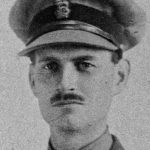



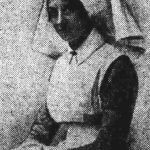


1. (Back) Although a few lists of men mentioned in despatches having been, ‘brought to the notice of the Secretary of State for War’ for services in France and Flanders had been published in the London Gazette prior to 1917, the first mentions in despatches for service in the United Kingdom were for the Easter Rising in Dublin in April 1916. They were published in January 1917 as being ‘brought to the notice of the Secretary of State for War for distinguished services rendered in connection with the War.’ (LG 25 January 1917; 29919. An additional list was published in LG 30 March 1917; 30005. The accompanying honours, decorations and medals had been published in an earlier Gazette—LG 24 January 1917; 29916.) Subsequently, mentions in despatches for service in the United Kingdom were awarded primarily to those (including pilots) engaged in anti-aircraft defences.
2. (Back) Recipients on Admiralty lists in 1919 are described as having been, ‘…brought to the notice of the Admiralty for valuables services in the prosecution of the war…’
3. (Back) The accompanying list of those who were mentioned in despatches, ‘for valuable services rendered in connection with anti-aircraft services in the United Kingdom’, was published in the London Gazette on 20 December 1917; 30439.
4. (Back) The accompanying list of those awarded decorations, medals and mentioned in despatches, ‘for valuable services rendered on the occasion of the sinking or damage by enemy action of Hospital Ships, Transports and Store Ships’, was published in the London Gazette on 6 September 1918; 30886.
5. (Back) The accompanying list of Honours for, ‘valuable services rendered within the Union of South Africa in connection with the Campaign in German South-West Africa and German East Africa’, was published in the London Gazette on 19 December 1918; 31075.
6. (Back) The accompanying list of those mentioned in despatches, ‘for valuable services rendered in connection with anti-aircraft services in the United Kingdom’, was published in the London Gazette on 20 February 1919; 31193.
7. (Back) The accompanying list of those receiving honours and medals for, ‘for valuable services rendered during the War in Military Record Offices in the United Kingdom’, was published in the London Gazette on 15 March 1919; 31232 (with honours to date from 1 January 1919).
‘Type ‘B’ Mentions’—Rewards for Valuable Services Published in The Times during the First World War
As I was working through one of the registers in my Royal Signals honours and awards project, I came across an anomaly. The obituary in The Wire for Major General A. C. Fuller CBE—the inventor of the Fullerphone—records that he was mentioned in despatches four times and that he did not receive the Victory Medal. These statements are at odds—if he did not serve in a theatre of war he could not have been mentioned in despatches. There are some exceptions to that statement, but Experimental Officers at the Signals Experimental Establishment were not amongst them. A little more digging revealed that these were ‘type ‘B’ mentions’ for ‘valuable services in connection with the war’. I was unable to track them down easily, however, and this post is the result of my research into where such awards may be found.
[image error]
An extract from War Office List of 23 March 1919 showing Scottish officers; the full list was not published in The Times. (The Courier, 23 August 1919.)
Meritorious service by military personnel and civilians at home was recognised largely only in the latter years of the war, primarily by the various grades of the Order of the British Empire, created in June 1917. In addition, a lower category of commendation, the equivalent in broad terms of a mention in despatches, was made available for those who were brought to the notice of the Secretary of State for War or Home Secretary. They are often referred to as ‘type ‘B’ mentions’. Most were for service in the United Kingdom, but some awards were made for service in the Dominions and Colonies.
Although the War Office, Air Ministry and Home Office lists, or communiqués, were described as supplements to the London Gazette, they did not appear in the Gazette but were instead provided to the Press for publication. Extracts may be found in regional newspapers, often highlighting the work of local recipients, but The Times became seen as the ‘official’ avenue of publication because it featured the full lists. The first communiqué appeared in February 1917 and the last in May 1920.[1] Similar lists were announced by the Admiralty, although they do not appear to have been published by The Times in the same way.[2]
Several lists were not published in The Times—for example, a list of Army officers dated 23 August 1919 may be found in part only as extracts in some regional newspapers.
In early 1920 a bronze spray of oak leaves was authorised for wear by those who had been mentioned in despatches (to be worn on the Victory Medal and retrospective to the beginning of the war), but no such emblem was authorised for type ‘B’ mentions. They were recorded, however, in the service records of military personnel.
[image error]
An extract from the service record of 924 (Acting) Company Quartermaster Sergeant George Dennis Ruggles, who was rewarded for his service with the Household Brigade Officer Cadet Battalion at Bushey in Hertfordshire.
Below are details of each of the lists—the date of the communiqué, the categories of those rewarded for their service, the ‘citation’ as published in The Times (which may differ in minor ways from that of the communiqué) and the details of when the list appeared in The Times. There are two good sources for the relevant pages of The Times, both require subscription: The Times archive and Fold3. Regional newspapers may be searched on sites such as The British Newspaper Archive.
War Office List—24 February 1917.
British Army Officers and Other Ranks, and Army Officers and Other Ranks in the Dominions and Colonies.
The names of the following have been brought to the notice of the Secretary of State for War for valuable services rendered in connection with the war.
The Times, 26 February 1917, p 12, continued p 13. British Army Officers.
The Times, 27 February 1917, p 11. British Army Other Ranks, and Army Officers and Other Ranks in the Dominions and Colonies.
War Office List—3 March 1917.
Military Nursing Services, Civilian Nurses and Voluntary Aid Detachments.
The names of the following ladies have been brought to the notice of the Secretary of State for War for valuable services rendered in connection with the war.
The Times, 5 March 1917, p 6.
War Office List—5 April 1917.
British Army Officers and Other Ranks.
The following are added to the names of those which have been brought to the notice of the Secretary of State for War for valuable services rendered in connection with the war.
The Times, 5 April 1917, p 9.
(Included are corrections to War Office List—24 February 1917.)
[image error]
Lieutenant Colonel Frederick Hibbert Westmacott FRCS, TD, Royal Army Medical Corps, (1867-1935) commanded 2nd Western General Hospital in the Manchester area from October 1915 to April 1917 before moving to France, where he commanded No. 57 General Hospital. He was mentioned in the War Office List of 5 April 1917. For his war service he was made CBE in 1919 (LG 3 June 1919; 31370.)
War Office List—7 August 1917.
British Army Officers and Other Ranks, and Army Officers and Other Ranks in the Dominions and Colonies.
The names of the following have been brought to the notice of the Secretary of State for War for valuable services rendered in connection with the war.
The Times, 7 August 1917, p 10.
(Included are corrections to War Office List—24 February 1917.)
War Office List—1 September 1917.
Royal Navy, Royal Naval Volunteer Reserve, Royal Marine and Royal Marine Artillery Officers.
The following are added to the names of those which have been brought to the notice of the Secretary of State for War for valuable services rendered in connection with the war, published on August 7, 1917.
The Times, 3 September 1917, p 10.
(Included are corrections to War Office List—7 August 1917.)
War Office List—18 September 1917.
Officers of the Medical Services.
The names of the following have been brought to the notice of the Secretary of State for War for valuable medical services rendered in connection with the war.
The Times, 19 September 1917, p 8.
War Office List—18 October 1917.
Military Nursing Services, Civilian Nurses and Voluntary Aid Detachments.
The names of the following have been brought to the notice of the Secretary of State for War for valuable services rendered in connection with the war.
The Times, 20 October 1917, p 4.
The Times, 22 October 1917, p 2.
The Times, 23 October 1917, p 4.
[image error]
Sister Miss Sara Burnley, Auxiliary Military Hospital, Ilkley, and Probationer Nurses Miss Dorothy Forster and Miss L. S. Sargent, St. Luke’s Hospital, Bradford. All were mentioned in the War Office List of 18 October 1917.
War Office List—20 December 1917.[3]
British Army Officers and Other Ranks (Anti-Aircraft Defences).
The names of the following have been brought to the notice of the Secretary of State for War for valuable services rendered in connection with anti-aircraft service in the United Kingdom, and, when applicable, an entry will be made in the records of service of officers and other ranks.
The Times, 21 December 1917, p 11.
War Office List—29 January 1918.
Patrons and Staff of Hospitals.
The names of the following ladies have been brought to the notice of the Secretary of State for valuable services rendered in connection with the establishment, maintenance, and administration of hospitals.
The Times, 2 February 1918, p 4.
War Office List—12 March 1918.
(1) Civilian Nurses and Voluntary Aid Detachments in the United Kingdom and Malta.
The names of the following have been brought to the notice of the Secretary of State for War for valuable nursing services rendered in connection with the war.
(2) Ladies of the Almeric Paget Military Massage Corps.
The following members of the Almeric Paget Military Massage Corps have been brought to the notice of the Secretary of State for War for valuable services rendered during the war.
The Times, 14 March 1918, p 4.
(Included are corrections to War Office Lists—3 March and 18 October 1917.)
War Office List—13 March 1918.
British Army Officers and Other Ranks, and Army Officers and Other Ranks in the Dominions and Colonies.
The names of the following have been brought to the notice of the Secretary of State for War for valuable services rendered in connection with the war, and when applicable an entry will be made in the records of service of officers and other ranks.
The Times, 15 March 1918, p 4. British Army Officers (surnames A-W).
The Times, 16 March 1918, p 10. British Army Officers (surnames W (continued)-Y) and Other Ranks, and Army Officers and Other Ranks in the Dominions and Colonies.
War Office List—1 May 1918.
Royal Army Medical Corps (one officer) and the Legation Guard, Peking.
The following are added to the names of those who have been brought to the notice of the Secretary of State for War for valuable services rendered in connection with the war, published on March 13, 1918.
The Times, 2 May 1918, p 4.
(Included are corrections to War Office Lists—24 February, 7 August, 18 September and 20 December 1917, and 13 March 1918.)
Air Ministry List—14 June 1918.
(1) Royal Air Force Officers and Other Ranks.
The following Officers and other ranks of the Royal Air Force have been brought to the notice of the Secretary of State in respect of the valuable services they have rendered in connection with the war, and a record to this effect will accordingly be made in their Official Records.
(2) Royal Air Force Civilians.
The following ladies and gentlemen employed by the Air Ministry have been brought to the notice of the Secretary of State War in respect of the valuable services they have rendered in connection with the war.
The Times, 15 June 1918, p 5.
War Office List—10 August 1918.
British and Dominion Military Nursing Services, Civilian Nurses and Voluntary Aid Detachments.
The names of the following ladies have been brought to the notice of the Secretary of State for War for valuable nursing services rendered in connection with the war.
The Times, 12 August 1918, p 10.
War Office List—12 August 1918.
Civilian Nurses and Voluntary Aid Detachments.
The names of the following ladies have been brought to the notice of the Secretary of State for War by the Chairman of the Joint War Committee of the British Red Cross Society and Order of St. John of Jerusalem in England for valuable nursing services rendered in connection with the war.
The Times, 13 August 1918, p 2.
War Office List—13 August 1918.
British Army Officers and Other Ranks, and Army Officers and Other Ranks in the Dominions and Colonies.
The names of the following have been brought to the notice of the Secretary of State for War for valuable services rendered in connection with the war, and when applicable, an entry will be made in the records of service of officers and other ranks.
The Times, 14 August 1918, p 2.
[image error]
1506 Warrant Officer Class II (Regimental Quartermaster Serjeant) George Henry Vooght, Machine Gun Corps, (1872-1949) a former sorting clerk and telegraphist with the General Post Office in Exeter. He was commended on the War Office List of 13 August 1918 for his service with the newly formed Tank Corps.
War Office List—14 August 1918.
Patrons and Staff of Hospitals.
The names of the following have been brought to the notice of the Secretary of State for War by the Chairman of the Joint War Committee of the British Red Cross Society and Order of St. John of Jerusalem in England for valuable services rendered in connection with the establishment, organisation, and maintenance of hospitals.
The Times, 15 August 1918, p 2.
War Office List—2 September 1918.
War Office Civilians.
The names of the following have been brought to the notice of the Secretary of State for War for valuable services rendered in connection with the war.
The Times, 3 September 1918, p 2.
The Times, 4 September 1918, p 11. Including civilians in organisations of the Dominions based in the United Kingdom.
War Office List—5 September 1918.
War Office Civilians.
The names of the following have been brought to the notice of the Secretary of State for War for valuable services rendered in connection with the war.
The Times, 7 September 1918, p 4.[4] Surnames A-G.
The Times, 9 September 1918, p 2. Surnames G (continued)-R.
The Times, 10 September 1918, p 11. Surnames R (continued)-Y.
War Office List—9 September 1918.
Civilian Staff of Welfare Institutions.
The names of the following have been brought to the notice of the Secretary of State for War for valuable services rendered in connection with the establishment and maintenance of Societies, Organisations and Institutions for the benefit of Naval and Military Forces.
The Times, 10 September 1918, p 11.
War Office List—4 November 1918.
(1) British Army Officers and Other Ranks.
The names of the following are to be added to those brought to the notice of the Secretary of State for War for valuable services rendered in connection with the war, which were published in the Press communiqué dated August 13, 1918.
(2) Patrons and Staff of Hospitals (two ladies).
The names of the following are to be added to those brought to the notice of the Secretary of State for War for valuable services rendered in connection with the war, which were published in the Press communiqué dated August 14, 1918.
(3) War Office Civilians.
The names of the following are to be added to those brought to the notice of the Secretary of State for War for valuable services rendered in connection with the war, which were published in the Press communiqués dated September 2 and 5, 1918.
(4) Civilian Staff of Welfare Institutions.
The names of the following are to be added to those brought to the notice of the Secretary of State for War for valuable services rendered in connection with the establishment and maintenance of Societies, Organisations and Institutions for the benefit of the Military Forces, which were published in the Press communiqué dated September 9, 1918.
The Times, 5 November 1918, p 12.
(Included are corrections to the War Office Lists—12 March, 13 March, 13 August, 14 August, 2 September, 5 September, and 9 September 1918.)
War Office List—23 November 1918.
Patrons and Staff of Hospitals.
The following have been brought to the notice of the Secretary of State for War by the Chairman of the Joint War Committee of the British Red Cross Society and Order of St. John of Jerusalem in England, for valuable services rendered in connection with the war.
The Times, 25 November 1918, p 2.
War Office List—19 December 1918.[5]
South African Army Officers, Other Ranks, Nurses and Civil Servants.
The names of the following have been brought to the notice of the Secretary for War for valuable services rendered within the Union of South Africa in connection with the Campaign in German South-West Africa and German East Africa.
The Times, 20 December 1918, p 4.
Air Ministry List—22 January 1919.
(1) Royal Air Force and Women’s Royal Air Force Officers and Other Ranks.
The following Officers and other ranks of the Royal Air Force (including personnel, Women’s Royal Air Force) have been brought to the notice of the Secretary of State in respect of the valuable services they have rendered in connection with the war, and a record to this effect will accordingly be made in the Official Records.
(2) Royal Air Force Civilians.
The following members of the Civilian Staff employed by or serving in connection with the Air Ministry have been brought to the notice of the Secretary of State War in respect of the valuable services rendered in connection with the war.
The Times, 23 January 1919, p 4.
War Office List—8 February 1919.
Patrons and Hospital Staff.
The following have been brought to the notice of the Secretary of State for War by the Chairman of the Joint War Committee of the British Red Cross Society and Order of St. John of Jerusalem in England, for valuable services rendered in connection with the war.
The Times, 10 February 1919, p 13.
War Office List—12 February 1919.
British Army Officers (three names) and War Office Civilians (two names).
The names of the following have been brought to the notice of the Secretary of State for War for valuable services rendered in connection with the war.
The Times, 13 February 1919, p 4.
Home Office List—January 1919.
Metropolitan Special Constabulary.
The names of the following members of the Metropolitan Special Constabulary have been brought to the notice of the Home Secretary for valuable services rendered during the war.
The Times, 14 February 1919, p 6.
War Office List—20 February 1919.[6]
Royal Naval Volunteer Reserve Officers and Ratings, and British Army Officers and Other Ranks.
The names of the following have been brought to the notice of the Secretary of State for War for valuable services rendered in connection with the anti-aircraft defences of the United Kingdom, and, where applicable, an entry will be made in the records of service of officers and other ranks.
The Times, 21 February 1919, p 4.
War Office List—4 March 1919.
(1) Civilian Doctors.
The names of the following Civil Medical Practitioners have been brought to the notice of the Secretary of State for War, for valuable medical services rendered in the United Kingdom in connection with the war.
(2) Civilian Staff of Welfare Institutions.
The names of the following have been brought to the notice of the Secretary of State for War for valuable services rendered in connection with the establishment and maintenance of Societies, Organisations, and Institutions for the benefit of the Military Forces.
The Times, 6 March 1919, p 18.
War Office List—7 March 1919.
War Office Civilians, Civilians in Districts and Commands, and Civilians in New Zealand and South African organisations in the United Kingdom.
The names of the following have been brought to the notice of the Secretary of State for War for valuable services rendered in the United Kingdom in connection with the war.
The Times, 8 March 1919, p 8.
[image error]
Miss Winifred Hills of Wealdstone, north London, was mentioned in War Office List of 7 March 1919 for her work in the Department of the Director General of Movements and Railways. She was well known in Harrow for her comedic talent in local amateur theatre productions.
War Office List—15 March 1919.[7]
(1) British Army Officers and Other Ranks at Military Record Offices.
The names of the following have been brought to the notice of the Secretary of State for War for valuable services rendered during the war in Military Record Offices in the United Kingdom, and, when applicable, an entry will be made in the records of service of officers and other ranks.
(2) Civilian Staff at Military Record Offices.
The names of the following have been brought to the notice of the Secretary of State for War for valuable services rendered during the war in Military Record Offices in the United Kingdom.
The Times, 17 March 1919, p 19.
War Office List—25 March 1919.
British Army Officers and Other Ranks, including Officers and Other Ranks of Queen Mary’s Army Auxiliary Corps.
The names of the following have been brought to the notice of the Secretary of State for War for valuable services rendered in connection with the war, and, when applicable, an entry will be made in the records of service of officers and other ranks.
The Times, 26 March 1919, p 19.
The Times, 27 March 1919, p 18.
War Office List—27 March 1919.
British Army Officers and Other Ranks, including Other Ranks of Queen Mary’s Army Auxiliary Corps.
The names of the following have been brought to the notice of the Secretary of State for War for valuable services rendered in connection with the war, and, when applicable, an entry will be made in the records of service of officers and other ranks.
The Times, 28 March 1919, p 19.
The Times, 29 March 1919, p 17. Including Officers and Other Ranks of the Dominions.
War Office List—8 April 1919.
Patrons and Staff of Hospitals.
The names of the following have been brought to the notice of the Secretary of State for War by the Chairman of the Joint War Committee of the British Red Cross Society and Order of St. John of Jerusalem in England for valuable services rendered in connection with the establishment, organisation and maintenance of hospitals.
The Times, 9 April 1919, p 10.
War Office List—15 April 1919.
Military Nursing Services, Civilian Nurses and Voluntary Aid Detachments.
The names of the following ladies have been brought to the notice of the Secretary of State for War for valuable nursing services rendered in connection with the war.
The Times, 17 April 1919, p 4.
Home Office List—13 August 1919.
Metropolitan Special Constabulary.
The names of the following members of the Metropolitan Special Constabulary have been brought to the notice of the Home Secretary for valuable services rendered during the war.
The Times, 18 August 1919, p 16.
War Office List—16 August 1919.
Civilian Doctors.
The names of the following Civil Medical Practitioners have been brought to the notice of the Secretary of State for War for valuable medical services rendered in the United Kingdom in connection with the war.
The Times, 16 August 1919, p 2.
War Office List—16 August 1919.
Patrons and Staff of Hospitals.
The names of the following have been brought to the notice of the Secretary of State for valuable services rendered in connection with hospitals in the United Kingdom during the war.
The Times, 16 August 1919, p 2.
War Office List—16 August 1919.
Civilian Staff of Welfare Institutions.
The names of the following have been brought to the notice of the Secretary of State for War for valuable services rendered in connection with the establishment and maintenance of Societies, Organisations and Institutions for the benefit of the Military Forces.
The Times, 16 August 1919, p 12.
War Office List—16 August 1919.
Civilian Nurses and Voluntary Aid Detachments.
The names of the following have been brought to the notice of the Secretary of State for War by the Chairman of the Joint War Committee of the British Red Cross Society and Order of St. John of Jerusalem in England for valuable nursing services rendered in connection with the war.
The Times, 18 August 1919, p 17.
War Office List—18 August 1919.
War Office Civilians.
The names of the following have been brought to the notice of the Secretary of State for War for valuable services rendered in connection with the war.
The Times, 18 August 1919, p 16, continued p 17.
War Office List—19 August 1919.
Military Nursing Services, Civilian Nurses and Voluntary Aid Detachments, including Nurses from/in the Dominions and Colonies.
The names of the following ladies have been brought to the notice of the Secretary of State for War for valuable nursing services rendered in connection with the war.
The Times, 19 August 1919, p 17.
War Office List—23 August 1919.
British Army Officers and Other Ranks.
The names of the following have been brought to the notice of the Secretary of State for War for valuable services rendered in connection with the war, and, when applicable, an entry will be made in the records of service of officers and other ranks.
Not published in The Times; extracts may be found in some regional newspapers dated 23 August 1919 and later.
War Office List—28 August 1919.
British Army Officers and Other Ranks, including Officers and Other Ranks of Queen Mary’s Army Auxiliary Corps.
The names of the following have been brought to the notice of the Secretary of State for War for valuable services in connection with the war, and, when applicable, an entry will be made in the records of service of officers and other ranks.
The Times, 28 August 1919, p 17, continued p 18.
The Times, 29 August 1919, p 16.
The Times, 1 September 1919, p 2, continued p 19. (This section is titled ‘Western and Irish Command Lists’. On page 2 are officers from Western Command and ladies of the Women’s Legion attached to Motor Transport Companies, followed by officers from XXIII Army Corps (surnames A-R). The continuation of the list on page 19 shows the remaining officers (surnames S-Y) and then other ranks surnames A-P. There then follows a statement that: ‘The remainder of this list will be published later.’ The remaining other ranks from XXIII Army Corps and all ranks from Irish Command do not appear to have been published in The Times.)
Air Ministry List—29 August 1919.
(1) Royal Air Force and Women’s Royal Air Force Officers and Other Ranks.
The following Officers and other ranks of the Royal Air Force (including personnel, Women’s Royal Air Force) have been brought to the notice of the Secretary of State in respect of the valuable services they have rendered in connection with the war, and a note to this effect will accordingly be made in Official Records.
(2) Royal Air Force Civilians.
The following members of the Civilian Staff employed by, or serving in connection with, the Air Ministry, have been brought to the notice of the Secretary of State War in respect of the valuable services rendered in connection with the war.
The Times, 29 August 1919, p 15.
War Office List—9 September 1919.
(1) Prisoners of War.
The names of the following have been brought to the notice of the Secretary of State for War for valuable services rendered whilst prisoners of war.
(2) War Office Civilians (two names).
The names of the following are to be added to those brought to the notice of the Secretary of State for War for valuable services rendered in connection with the war, which were published in the Press communiqué dated Sept. 5, 1918.
(3) War Office Civilians (two names).
The names of the following are to be added to those brought to the notice of the Secretary of State for War for valuable services rendered in connection with the war, which were published in the Press communiqué dated March 7, 1919.
(4) British Army Other Ranks.
The names of the following are to be added to those brought to the notice of the Secretary of State for War for valuable services rendered in connection with the war, which were published in the Press communiqué dated March 25, 1919.
(5) British Army Officers and Other Ranks.
The names of the following are to be added to those brought to the notice of the Secretary of State for War for valuable services rendered in connection with the war, which were published in the Press communiqué dated March 27, 1919.
(6) Hospital Staff.
The names of the following are to be added to those brought to the notice of the Secretary of State for War for valuable services rendered in connection with the establishment, organisation, and maintenance of hospitals, which were published in the Press communiqué dated April 8, 1919.
(7) Military Nursing Services, Civilian Nurses and Voluntary Aid Detachments, including some from the Dominions.
The names of the following are to be added to those brought to the notice of the Secretary of State for War for valuable nursing services rendered in connection with the war, which were published in the Press communiqué dated April 15, 1919.
The Times, 9 September 1919, p 15.
(Included are corrections to the War Office Lists—13 August, 2 September, 5 September, 9 September, and 4 November 1918, and 8 February, 12 February, 4 March, 7 March, 25 March, 27 March (a deletion) and 8 April 1919.)
War Office List—9 February 1920.
(1) Patrons and Staff of Hospitals.
The names of the following have been brought to the notice of the Secretary of State for War by the Chairman of the Joint War Committee of the British Red Cross Society and Order of St. John of Jerusalem in England for valuable services rendered in connection with the establishment, organisation and maintenance of hospitals.
(2) Officers of the British War Mission to the United States.
The names of the following have been brought to the notice of the Secretary of State for War for valuable services rendered in the United States of America in connection with the war, and, when applicable, an entry will be made in the records of service of the officers.
(3) Civilian Nurses and Voluntary Aid Detachments.
The names of the following have been brought to the notice of the Secretary of State for War for valuable services in connection with the war.
(4) British Army Officers.
The names of the following officers are to be added to those brought to the notice of the Secretary of State for War for valuable services rendered in connection with the war, which were published in the Press communiqué dated August 13, 1919.
(5) Civilian Doctors.
The names of the following are to be added to those brought to the notice of the Secretary of State for War for valuable medical services rendered in the United Kingdom in connection with the war, which were published in the Press communiqué dated August 16, 1919.
(6) Civilian Staff of Welfare Institutions.
The names of the following are to be added to those brought to the notice of the Secretary of State for War for valuable services rendered in connection with the establishment and maintenance of Societies, Organisations and Institutions for the benefit of the Military Forces, which were published in the Press communiqué dated August 16, 1919.
(7) Voluntary Aid Detachments and Civilian Nurses.
The names of the following are to be added to those brought to the notice of the Secretary of State for War by the Chairman of the Joint War Committee of the British Red Cross Society and Order of St. John of Jerusalem in England for valuable nursing services rendered in connection with the war, which were published in the Press communiqué dated August 16, 1919.
(8) War Office Civil Servants.
The names of the following are to be added to those brought to the notice of the Secretary of State for War for valuable services rendered in connection with the war, which were published in the Press communiqué dated August 18, 1919.
(9) Military Nursing Services, Voluntary Aid Detachments and Civilian Nurses, including Nurses from/in the Dominions and Colonies.
The names of the following ladies are to be added to those brought to the notice of the Secretary of State for War for valuable nursing services rendered in connection with the war, which were published in the Press communiqué dated August 19, 1919.
(10) British Army Officers and Other Ranks.
The names of the following are to be added to those brought to the notice of the Secretary of State for War for valuable services rendered in connection with the war, which were published in the Press communiqué dated August 23, 1919.
(11) British Army Officers and Other Ranks and Army Officers and Other Ranks in the Dominions and Colonies.
The names of the following are to be added to those brought to the notice of the Secretary of State for War for valuable services rendered in connection with the war, which were published in the Press communiqué dated August 28, 1919.
The Times, 10 February 1920, p 17.
(Included are corrections to the War Office Lists—18 October 1917, 25 March, 16 August, 18 August, 19 August, 23 August and 28 August 1919.)
War Office List, 14 May 1920 (to be dated 28 August 1919).
British Army Officers and Other Ranks.
The names of the following have been brought to the notice of the Secretary of State for War for valuable services rendered in connection with the anti-aircraft defences of the United Kingdom, and, where applicable, an entry will be made in the records of service of officers and other ranks.
The Times, 15 May 1920, p 6.
Some of those ‘mentioned’:







1. (Back) Although a few lists of men mentioned in despatches having been, ‘brought to the notice of the Secretary of State for War’ for services in France and Flanders had been published in the London Gazette prior to 1917, the first mentions in despatches for service in the United Kingdom were for the Easter Rising in Dublin in April 1916. They were published in January 1917 as being ‘brought to the notice of the Secretary of State for War for distinguished services rendered in connection with the War.’ (LG 25 January 1917; 29919. An additional list was published in LG 30 March 1917; 30005. The accompanying honours, decorations and medals had been published in an earlier Gazette—LG 24 January 1917; 29916.) Subsequently, mentions in despatches for service in the United Kingdom were awarded primarily to those (including pilots) engaged in anti-aircraft defences.
2. (Back) Recipients on Admiralty lists in 1919 are described as having been, ‘…brought to the notice of the Admiralty for valuables services in the prosecution of the war…’
3. (Back) The accompanying list of those who were mentioned in despatches, ‘for valuable services rendered in connection with anti-aircraft services in the United Kingdom’, was published in the London Gazette on 20 December 1917; 30439.
4. (Back) The accompanying list of those awarded decorations, medals and mentioned in despatches, ‘for valuable services rendered on the occasion of the sinking or damage by enemy action of Hospital Ships, Transports and Store Ships’, was published in the London Gazette on 6 September 1918; 30886.
5. (Back) The accompanying list of Honours for, ‘valuable services rendered within the Union of South Africa in connection with the Campaign in German South-West Africa and German East Africa’, was published in the London Gazette on 19 December 1918; 31075.
6. (Back) The accompanying list of those mentioned in despatches, ‘for valuable services rendered in connection with anti-aircraft services in the United Kingdom’, was published in the London Gazette on 20 February 1919; 31193.
7. (Back) The accompanying list of those receiving honours and medals for, ‘for valuable services rendered during the War in Military Record Offices in the United Kingdom’, was published in the London Gazette on 15 March 1919; 31232 (with honours to date from 1 January 1919).

